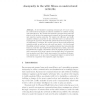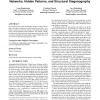17 search results - page 1 / 4 » Resisting structural re-identification in anonymized social ... |
PVLDB
2008
13 years 4 months ago
2008
We identify privacy risks associated with releasing network data sets and provide an algorithm that mitigates those risks. A network consists of entities connected by links repres...
EDBT
2010
ACM
13 years 8 months ago
2010
ACM
With more and more social network data being released, protecting the sensitive information within social networks from leakage has become an important concern of publishers. Adve...
PET
2007
Springer
13 years 10 months ago
2007
Springer
Abstract. As decentralized computing scenarios get ever more popular, unstructured topologies are natural candidates to consider running mix networks upon. We consider mix network ...
DASFAA
2011
IEEE
13 years 2 months ago
2011
IEEE
\Identity disclosure" problem on publishing social network data has gained intensive focus from academia. Existing k-anonymization algorithms on social network may result in n...
WWW
2007
ACM
14 years 5 months ago
2007
ACM
In a social network, nodes correspond to people or other social entities, and edges correspond to social links between them. In an effort to preserve privacy, the practice of anon...


